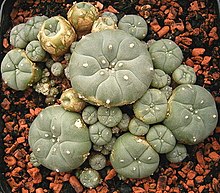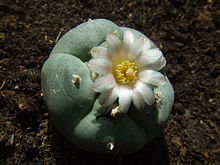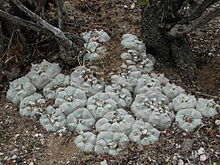Peyote
The peyote (Lophophora williamsii) is a small, spineless cactus that contains psychoactive alkaloids, particularly mescaline. Peyote is a word derived from the Nahuatl peyōtl ([ˈpejoːt͡ɬ]), meaning "caterpillar cocoon", from a root peyōni, "to glisten". It flowers from March to May, and sometimes as late as September. The flowers are pink, with thigmotactic anthers (like Opuntia).
Known for its psychoactive properties when ingested, peyote has at least 5,500 years of entheogenic and medicinal use by indigenous tribes.
The various species of the genus Lophophora grow low to the ground and they often form groups with numerous, crowded shoots. The blue-green, yellow-green, or sometimes reddish-green shoots are mostly flattened spheres with sunken shoot tips. They can reach heights of 2 to 7 centimeters (0.79 to 2.76 in) and diameters of 4 to 12 cm (1.6 to 4.7 in). There are often significant, vertical ribs consisting of low and rounded or hump-like bumps. From the cusp, areoles arises a tuft of soft, yellowish, or whitish woolly hairs. Spines are absent. Flowers are pink or white to slightly yellowish, sometimes reddish. They open during the day, are from 1 to 2.4 cm long, and reach a diameter from 1 to 2.2 cm.
Lophophora williamsii seedling at roughly 1+1⁄2 months of age
The cactus produces flowers sporadically; these are followed by small edible pink fruit. The club-shaped to elongated, fleshy fruits are bare and more or less rosy colored. At maturity, they are brownish-white and dry. The fruits do not burst open on their own and they are between 1.5 and 2 cm long. They contain black, pear-shaped seeds that are 1 to 1.5 mm long and 1 mm wide. The seeds require hot and humid conditions to germinate. Peyote contains a large spectrum of phenethylamine alkaloids. The principal one is mescaline for which the content of Lophophora williamsii is about 0.4% fresh (undried) and 3–6% dry.
Peyote is extremely slow-growing. Cultivated specimens grow considerably faster, sometimes taking less than three years to go from seedling to mature flowering adult. More rapid growth can be achieved by grafting peyote onto mature rootstock. The top of the above-ground part of the cactus, the crown, consists of disc-shaped buttons. These are cut above the roots and sometimes dried. When done properly, the top of the root forms a callus and the root does not rot. When poor harvesting techniques are used, however, the entire plant dies. Currently, peyote grows naturally but has been over-harvested, to the point that the state has listed it as an endangered species. The buttons are generally chewed, or boiled in water to produce a psychoactive tea. Peyote is extremely bitter and most people are nauseated before they feel the onset of the psychoactive effects. Most side effects don't set in until 2–3 hours after taking. The effects last about 10 to 12 hours.
Peyote is reported to trigger rich visual or auditory effects and spiritual or philosophical insights.
In addition to psychoactive use, some tribes use the plant in the belief it may have curative properties. They employ peyote for such varied ailments as toothache, pain in childbirth, fever, breast pain, skin diseases, rheumatism, diabetes, colds, and blindness. Although uncommon, the use of peyote and mescaline has been associated with clinically significant effects requiring treatment. It can be used in various preparations for neurasthenia, hysteria, and asthma.
Remove these ads. Join the Worldbuilders Guild












Comments